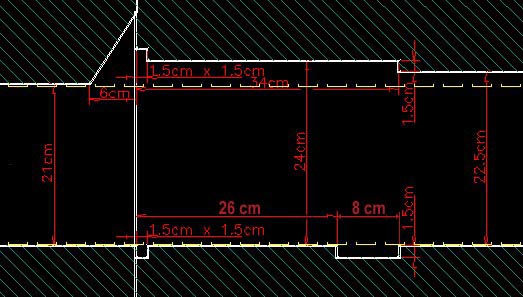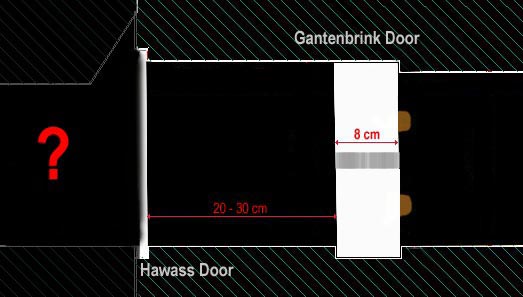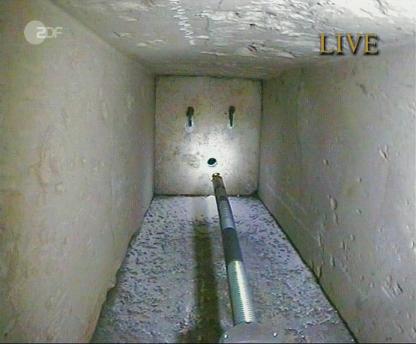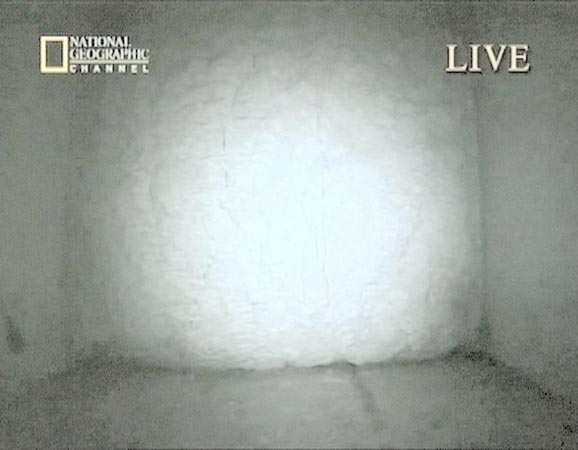
An
Analysis of the Plugs Found
in the Queen's Chamber Southern Shaft
Another Double Door?
Although I was unable to watch the National Geographic special I have looked closely at the many pictures that have been posted on the web over the past few days. As with any over hyped affair, some disappointment is to be expected from much of the audience who had tuned in eagerly, perhaps hoping to witness the discovery of a hidden treasure trove of pharaoh's gold or even as Dr Hawass was reported as speculating, the real burial chamber of Khufu. Now Rudolf Gantenbrink, the original discoverer of the first 'door' in the Queen's chamber shaft, has come forward and suggested that what might eventually be found at the end of this shaft is the burial chamber of Hetepheres, the mother of Khufu.
"It's
the tomb of Hetepheres, the Mother of Cheops. I know it for sure :-)) "
- Rudolf
Gantenbrink.
I must admit that I was quite surprised to read Gantenbrink suggesting such a thing as he had in the past refrained from any speculation of what might be found behind the limestone plug. Perhaps that 'smiley face' :-)) at the end of his statement indicates that his words were spoken in jest, possibly even poking fun at Zahi Hawass's previous statement that we might find the real burial chamber of Khufu there.
Then again, perhaps not.
On his website, Gantenbrink discusses what he views as a "complete anomaly" in the section of the King's chamber southern shaft that is situated just above the region where the 'doors' are in the Queen's chamber southern shaft. He writes of the vertical joint in the King's Chamber shaft as evidence suggesting the possible existence of an as yet undiscovered chamber near by:
"Between Block No. 15 and 16 we discovered a vertical joint. In the shafts
such joints, which have a distinct static function, otherwise occur only
proximate to the chambers. (For more information on the normal arrangement of
joints, see GENERAL REMARKS at THE FINDINGS page.)
It is a complete anomaly to find a vertical joint fully isolated in the nucleus
of the pyramid.
Since it requires much greater effort to shape and fit the blocks in such an
arrangement, we can assume that the builders must have had significant
structural justification for going to the trouble of deflecting forces into the
horizontal plane.
This vertical joint is located about 12 meters above a point in the lower
southern shaft which is subject to extraordinary static influences (see LOWER
SOUTHERN SHAFT , BLOCK No. 25).
The overall static's in this area seem to differ from those in the other shaft
segments.
For a construction engineer this is a significant clue to the possible existence of an as yet undiscovered structure in the vicinity of these static anomalies."

To
further support the suggestion of a hidden chamber between the upper and lower
south shafts, Gantenbrink writes of the apparent downward force on the Queen's
chamber south shaft:
"At the beginning of Block No. 26 , a large section of the floor has broken away. This is the worst damage we observed anywhere in the shaft sequences so far investigated. At this point, however, the pressure on the shaft amounts to only one-third of the maximum value. Near the Queen's Chamber, 115 meters of pyramid material press downward on the shaft. But only 35 meters of material press down on this spot, where we observe the greatest shaft damage. This highly unusual finding can have resulted only from one of two possible causes:
1. Extremely inept construction work below Block No. 25 and 26. It must be remembered, however, that it is this final section of the shaft which otherwise displays the highest quality workmanship observed anywhere in the shafts system.
2. The existence of an as yet undiscovered structure below or above this shaft section. Such a structure could produce a pressure peak, which could in turn focus considerable additional force on the shaft and possibly cause the observed damage."
If we look further up the King's chamber shaft for more clues we find a section of the shaft located between block 23 and block 24 that reflects what we now know of the design of the Queen's Chamber southern shaft. Here, just before the end of block 23, are small niches on both sides of the shaft about 1.5 cm deep. These niches, being 8 cm wide, are the same thickness as the limestone slab known as 'Gantenbrink Door' in the Queen's chamber shaft and could well have been intended to hold a similar limestone slab. Just 26 cm behind this missing slab are two more niches that were probably intended to hold another slab or partition of some sort. It is also at this point that block 23 meets block 24 and we find the unusual coinciding of joints in both the floor and the roof of the shaft. Of all the other blocks in all of the explored shafts, these are the only two that join in this manner.

The Niches in the King's chamber southern shaft as viewed from above
Now lets return to the Queen's chamber shaft and look again at the double door arrangement there:

The Queen's Chamber southern shaft as viewed from above
The newly discovered second slab has already become known as the 'Hawass Door', after Zahi's previously stated opinion that this second stone is in fact another door. What we now know of the Queen's chamber shaft design from this most recent exploration by the National Geographic team is that the 'Gantenbrink Door' that was drilled through was measured to be a fraction less than 8 cm thick. Such a thickness would allow the slab to fit snuggly in the 8 cm wide niches of the King's chamber southern shaft.

Inserting the camera through the hole in 'Gantenbrink's Door'

A view of the 'Hawass Door' through the hole drilled in the 'Gantenbrink Door'
What we are looking at above is an enhanced picture taken by the National Geographic robot's camera after it was pushed through the hole that had been drilled through the first limestone slab.
It can be observed that this second stone slab is not flush against the back side of the first slab, instead it is what appears to be about 20-30 cm behind, fitting with the 26 cm gap between the niches in the King's chamber shaft. In my opinion, this empty gap is of great significance.
The 'double door' design of the King's chamber shaft is clearly duplicated in the explored section of the Queen's chamber shaft.
Does the rest of the King's chamber southern shaft give an indication of what is to be found behind the second slab in the Queen's chamber shaft?
If so, then the implication would be that the 'Hawass Door' is not simply an unfinished core block as has been suggested by some, nor would we find behind it a third blocking stone as others have speculated. Instead, we would find that the shaft continues beyond this second closure stone just as the King's chamber shaft continues beyond its own double set of niches, niches that were probably designed to hold slabs like those in the Queen's chamber southern shaft.
"We can see another sealed door.
It looks to me like it is sealing something.
It seems that something important is hidden there.
This
is one of the first major discoveries in the Great Pyramid in some 130 years,
and now what we need is time for further analysis"
Mother of the Pyramid
The Hidden Tomb of Hetepheres